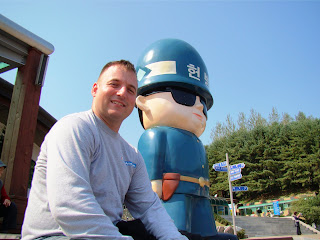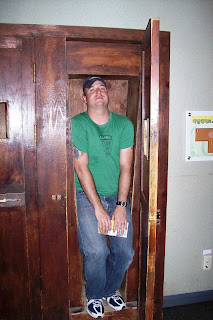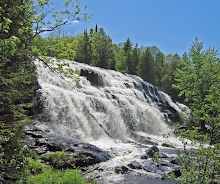Thursday, December 4, 2008
Thanksgiving
Saturday, October 18, 2008
Re-Mix or Remaster Death Magnetic!
Re-Mix or Remaster Death Magnetic!
Saturday, October 4, 2008
DMZ Trip
The Korean DMZ is a buffer zone between North and South Korea. It cuts the peninsula roughly in half crossing the infamous 38th parallel. It is 155 miles long and approximately 2.5 miles wide although much narrower in some places (especially near the Joint Security Area or JSA). It is regarded as the most heavily armed border in the world. The ceasefire that ended full-scale fighting at the end of the Korean War and created the DMZ was signed 27 July 1953. Each side agreed to pull their troops back 2000m from the front line, this created a buffer zone 2.5 miles wide. The Military Demarcation Line or MDL goes down the center of the DMZ and is exactly where the front was the day the cease fire was signed. Technically the two sides are still at war and large numbers of troops are stationed along the DMZ. The armistice only allows certain types of weapons and a specific number of troops allowed in the DMZ. Both sides are free to patrol the DMZ but cannot cross the MDL. Sporadic outbreaks of violence between the North and South due to northern aggression have killed over 500 ROK soldiers and 50 US soldiers from 1953 to 1999. There have been several notable incursions in the DMZ to which the North Korean government has not recognized any responsibility for.
Three tunnels dug by the North have been discovered in the mid-Seventies and a fourth in 1990. They were discovered with the help of a North Korean defector that worked on the tunnels. Two of the tunnels are large enough for tanks and the smallest one (open to the public) is for personnel only. The North Koreans claimed that they where coal mines, even smearing coal on the walls of the tunnel. It is believed there may be up to 13 undiscovered tunnels in the DMZ. It is estimated that a brigade-sized element could be moved through the tunnels in 45 minutes.
We got to go into the third tunnel (the personnel one), but no pictures were allowed. It’s very low and I had to duck my head down the whole time. It dead ends at a concrete wall put up at the point of the MDL.
On 18 August 1976 a group of Korean civilians escorted by a security team commanded by CPT Arthur Bonifas and his ROK Army counterpart CPT Kim and one of CPT Bonifas’ platoon leaders 1LT Mark Barrett along with 11 enlisted men both US and ROK went to the JSA to trim a tree that blocked the view of a checkpoint (CP#3) adjacent to the Bridge of No Return. The North Koreans had made several attempts to kidnap personnel in CP#3 and drag them across the bridge into North Korea. The checkpoint was nicknamed ‘The Loneliest Outpost in the World’ because it was so close to the MDL and it was surrounded by North Korean checkpoints. The trimming was scheduled with the KPA. The soldiers and officers where all unarmed as the amount of firearms in the JSA are limited by treaty, they did however have axes that were brought to prune the tree.

As the trimming began 15 KPA soldiers approached commanded by Senior Lt Pak Chul a man with a history of confrontations with UNC personnel. The KPA soldiers watched and then told CPT Bonifas to stop. He ignored this request. Soon 20 more KPA soldiers arrived and Senior Lt Pak Chul again demanded that the trimming cease. CPT Bonifas again ignored him. Pak Chul took off his watch wrapped it in a handkerchief, placed it in his pocket and gave the order, “Kill them!” as he swung an axe into CPT Bonifas’ neck. CPT Bonifas and 1LT Barrett where killed and all but one of the UNC guards were wounded in the incident.
The North claimed that the incident was an unprovoked attack on KPA guards led by the American officers and urged the Non-Aligned Nations to demand the removal of US troops from Korea. With details of the incident unavailable and rather than wait for clarification the resolution passed.
In response the US government launched an operation to cut down the tree with overwhelming force called Operation Paul Bunyan. The operation was meant to be a show of ROK/US solidarity and force. The operation consisted of 27 vehicles, 16 engineers, 60 JSA security guards, and a 64 man ROK Special Forces team to do the actual cutting. Behind them where an infantry company, 27 helicopters, numerous fighters from Osan and Kunsan and the aircraft carrier Midway was on alert just offshore. Al told the task force for Operation Paul Bunyan consisted of 813 men. The tree fell without incident and the stump remained there as a reminder until 1987 when it was replaced by a monument. The checkpoint in question was used until the mid-1980s when cement posts where installed to prevent use of the bridge.
We got to see the checkpoint, the place where the tree once stood and the Bridge of No Return.
 A view of Gijeong-dong AKA Propaganda Village in the DMZ on the North Korea side, the communists call it Peace Village. It was built by the North in response to Daeseong-dong, the only village within the DMZ in the South. The North says it is inhabited by farmers but the truth is it's nearly deserted. The windows of the large buildings contain no glass and vehicles are seldom seen. The only inhabitants are some carteakers and a few farmers. Lights seem to come on and off at the same times every day. It does have a very large flagpole, in fact it is the largest in the world at 160m. It was built after the South built a 90m tall flagpole.
A view of Gijeong-dong AKA Propaganda Village in the DMZ on the North Korea side, the communists call it Peace Village. It was built by the North in response to Daeseong-dong, the only village within the DMZ in the South. The North says it is inhabited by farmers but the truth is it's nearly deserted. The windows of the large buildings contain no glass and vehicles are seldom seen. The only inhabitants are some carteakers and a few farmers. Lights seem to come on and off at the same times every day. It does have a very large flagpole, in fact it is the largest in the world at 160m. It was built after the South built a 90m tall flagpole. Panmunjeom, the Joint Security Area looking into North Korea. These buildings are used as a meeting place between North and South Korea. The concrete slab is the MDL, it bisects the buildings here.
Panmunjeom, the Joint Security Area looking into North Korea. These buildings are used as a meeting place between North and South Korea. The concrete slab is the MDL, it bisects the buildings here. Looking into North Korea from the MDL.
Looking into North Korea from the MDL. Me in front of the MDL, North Korea is beyond that. The MDL is the tree line behind me, I'm very close to communism at this point.
Me in front of the MDL, North Korea is beyond that. The MDL is the tree line behind me, I'm very close to communism at this point. The sire of the Axe Murders today, the blue building is (CP#3) and the Bridge of No Return is just to the right.
The sire of the Axe Murders today, the blue building is (CP#3) and the Bridge of No Return is just to the right. The bridge today.
The bridge today. Resting after running up the steep .5 mile ramp out of the tunnel.
Resting after running up the steep .5 mile ramp out of the tunnel.
Wednesday, September 24, 2008
Rock Band-guy
Monday, September 22, 2008
Skool Update
So now I'm registered at American Military University an online only school that has military-type degree plans. So far so good. Registering was easy no problems with the TA but the term doesn't start until 06 Oct, so we'll see if I can access the courses. The best part is that my books are paid for with my TA which is very uncommon, so I pay nothing out of pocket. Wish me luck.
Courses for Fall term -
RQ295 - Foundations of Online blah, blah, blah
Basically a BS prerequisite most online schools have these. They suck and don't transfer a complete waste of time and money.
RQ301 - Intro to Military History
Sounds like fun, I'll take it.
Guess my major?
Sorry for the delay.
Wednesday, September 3, 2008
Aaarrgh!
Tuesday, August 26, 2008
Seoul stuff





 Isadong one of the districts of Seoul. This one is downtown and full of shops, restaurants and street vendors.
Isadong one of the districts of Seoul. This one is downtown and full of shops, restaurants and street vendors.

 One of the many protests in the city. Here the police are ready for trouble.
One of the many protests in the city. Here the police are ready for trouble. Some sort of outdoor concert. Girls where pretty but not my cup of tea.
Some sort of outdoor concert. Girls where pretty but not my cup of tea. Musicians playing before some sort of martial arts match.
Musicians playing before some sort of martial arts match.
 The contestants in the match. The match was played in a back alley theater area.
The contestants in the match. The match was played in a back alley theater area. A poster of the 'glorious leader' to the north.
A poster of the 'glorious leader' to the north.
The park was full of men playing some sort of game. The whole area stunk of Soju and cigs.
 Sucks to be that guy.
Sucks to be that guy. I'm not so sure she knows what her T-shirt says. Engrish returns! It's everywhere!
I'm not so sure she knows what her T-shirt says. Engrish returns! It's everywhere! I did not want to eat here.
I did not want to eat here.
Seoul Day 2 (part 1)
The second day we visited Changdeokgung Palace, Changgyeonggung Palace, The Central Buddhist Museum and the temple next to it (can recall the name), and Mahabodhi Temple.
 The front gate of Changdeokgung Palace.
The front gate of Changdeokgung Palace.
 Cool details like this are all over these palaces.
Cool details like this are all over these palaces.

 The throne room.
The throne room.
The Seoul Tower in the distance.


 The royal families' pond out back.
The royal families' pond out back.
Thursday, August 7, 2008
Seoul Day 1 (part 4)
 Korean police on the way to the museum. When the picture was taken they both looked at each other.
Korean police on the way to the museum. When the picture was taken they both looked at each other. The arch in front of the prison.
The arch in front of the prison. A wonderful contraption called the 'standing coffin'.
A wonderful contraption called the 'standing coffin'. Me trying to fit my fat ass into the 'standing coffin'.
Me trying to fit my fat ass into the 'standing coffin'. These bricks where made by the prisoners and used to build the prison. Like digging your own grave.
These bricks where made by the prisoners and used to build the prison. Like digging your own grave. A guard tower on the perimeter wall.
A guard tower on the perimeter wall.
 The courtyard between the wings.
The courtyard between the wings. One of the men's wings.
One of the men's wings. The female cells, they where built underground and exhumed for the museum.
The female cells, they where built underground and exhumed for the museum.At the end of the day we went to the COEX mall. It's a huge, underground mall filled with all sorts of stores.
 Sousage=Engrish
Sousage=Engrish Korean McDonalds, pretty much the same except they put BBQ sauce on everything. Kinda like the French-Canadians and the mayo. Good luck trying to order a burger with or without anything, there is an obvious language barrier.
Korean McDonalds, pretty much the same except they put BBQ sauce on everything. Kinda like the French-Canadians and the mayo. Good luck trying to order a burger with or without anything, there is an obvious language barrier.
 Korean fast food chain.
Korean fast food chain.

